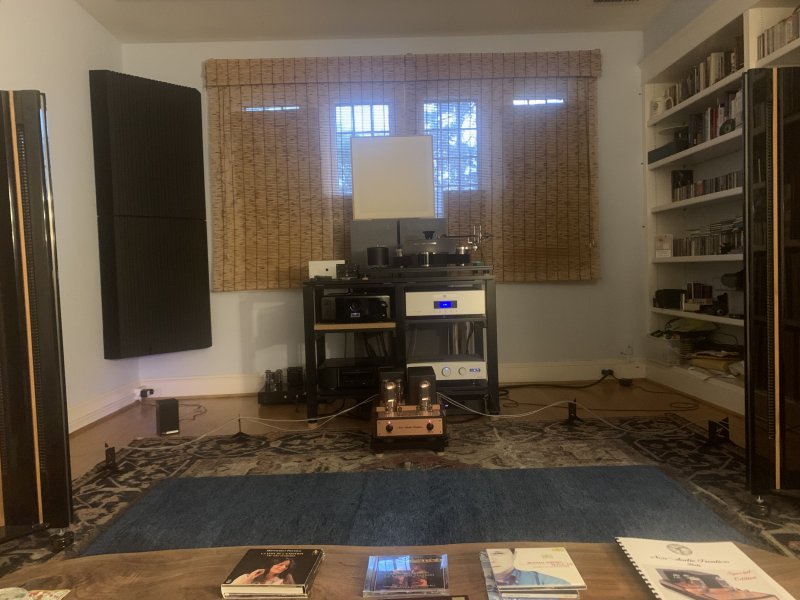I own a Mosart Audio Rack: Please forgive a long "review" here, but I think my experience may be of wider interest to readers.
Sometimes it takes an entirely new perspective. In the world of audio racks, there isn’t huge variation. The “serious” racks, which start close to $10,000 and rise steeply from there, are usually made of steel, aluminum and/or wood, with various additions in acrylic and a variety of dampers and/or different forms of suspension to isolate the shelves and a multitude of spikes.
Along comes Bruce Schuettinger, a designer of very high-end (and rather striking) furniture at a company called Mosart Fine Art Furniture. This isn’t your average expensive furniture – the company has won all manner of awards for its designs. The relevance here is that Bruce also happens to be an audiophile. After many years, the two parts of his mental world came together in some truly creative thinking about audio support structures. Bruce’s solution turned out to be Richlite Black Diamond. What is this stuff? Well, a simplistic way to put it is “compressed paper.” But more technically: it’s made out of approximately 65% FSC®-certified or recycled paper content and 35% phenolic resin. To quote from the manufacturer:
"The process of creating Richlite is both simple and complex. Rolls of paper are saturated with a thermosetting resin before being cut to length and laid up by hand. Each sheet is carefully stacked, and the direction of the paper alternated, creating the ultimate balance and stability. The stacks are then pressed under even heat and pressure, which bonds the layers of paper together and cures the resin. Slowly cooled, the cured panels produce a solid, stable sheet of material."
So the frame made out of Richlite – but built just as is Mosart’s fine furniture, with the joinery made up of slotted mortice and tenons and lap joints. The shelves, also made of Richlite, are adjustable, with cork foundations (on request), isolated from the frame with E.A.R. Isodamp spacers. The bottom shelves have vented and slotted panels for heat distribution. The legs of the rack are finished with Richlite discs, cork, and Isodamp spacers, all joined together by threaded steel rods, lock nuts and isolated threat brass plates. The whole frame can be finished with varnish and with beautiful wood inlays should the buyer so desire. The resulting racks are very heavy indeed (no, I didn’t put mine on a scale – I just watched two gentleman working very hard to get the empty frame up one flight of stairs). Since the entire rack is built by hand and to order, the dimensions, number of shelves, and the original spacing of the shelves are all agreed in advance.
I have heard the rack in two systems. First, my own (See photo and sorry for the slope! Alsyvox Tintoretto

speakers, Audio Note CD player and Scheu analog das laufwerk No.2 turntable with Tru Glider arm; Viva, Backert Labs and McGary SA-1 Special Edition or NAF 845 SE amps) and the system at Dr. Vinyl’s home (which changes over time but is never less than first-class). Naturally, I heard both systems “before” and “after.” Rather than go through the list of audiophile observations (the highs, the midrange, the bass, the soundstage, the texture... etc), I would ask readers instead: how do you describe a great live musical experience? You don't describe any of these terms. Rather, you describe the performance itself. Listening through my Alysvox Tintoretto speakers with all components on the Mosart rack and the amp on a Mozart amp stand has my wife and I reacting to the sound in exactly the same way - being deeply moved, passionate, bored or even, on rare occasions, annoyed about a particular performance.
The transformation was between constant consciousness of the components to the focus on the musical experience. I don’t mean to be naïve here: of course, my system and Dr. Vinyl’s sounded different. But the relative improvements were both very clear: With the Mosart rack you can hear every change in equipment or positioning of speakers. Of course, bad recordings are still bad recordings. The point, rather, is that you relax
into the sound: it’s just etched and locked in space in both rooms in a radically more relaxing way than with our respective earlier racks. You can expect to spend from $8500 up to close to $20,000 for a large, highly-finished rack. Not cheap - but it’s an immediately audible, and IMHO major upgrade. Disclaimers – no A/B comparison with super-expensive stands. But I can say this: the Mosart rack's seminal virtue is that is makes a serious and major contribution to removing the system from one's consciousness. I apologize if this all seems gushy - but there is so much over-hype in this hobby, that a courageous and successful new approach deserves attention.



